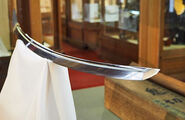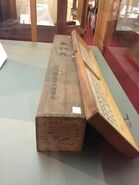About the Blade
Swordsmith
Houki Yasutsuna (伯耆安綱)
Forge Date
Heian period (10-11th century)
Inscription
国綱
Kunitsuna
Kunitsuna
Current Sword Length
84.4cm
Current Blade Hamon (Historical)
?
Sheath
Current Location
Kitano Tenmangu Shrine, Kamigyou-ku, Kyoto
Public Viewing
Yes,
– Kyoto National Museum (Kyoto), December 15, 2015 - January 17, 2016
– Kitano Tenmangu Shrine (Kyoto), April 16 - May 31, 2016
– Kitano Tenmangu Shrine (Kyoto), July 1 - August 31, 2016
– Edo-Tokyo Museum (Tokyo), November 23, 2016 - January 29, 2017
– Kitano Tenmangu Shrine (Kyoto), January 21, 2017 - March 31, 2017
– Yonezawa City Uesugi Museum (Yamagata), May 25, 2017 - June 18, 2017
– Kitano Tenmangu Shrine (Kyoto), July 15 - August 31, 2017
– Kyoto National Museum (Kyoto), December 15, 2015 - January 17, 2016
– Kitano Tenmangu Shrine (Kyoto), April 16 - May 31, 2016
– Kitano Tenmangu Shrine (Kyoto), July 1 - August 31, 2016
– Edo-Tokyo Museum (Tokyo), November 23, 2016 - January 29, 2017
– Kitano Tenmangu Shrine (Kyoto), January 21, 2017 - March 31, 2017
– Yonezawa City Uesugi Museum (Yamagata), May 25, 2017 - June 18, 2017
– Kitano Tenmangu Shrine (Kyoto), July 15 - August 31, 2017
Blade Appearance
History
- One of the more popular iterations of Higekiri's (and by extension Hizamaru's) origin depicts a competition between two famous swordsmiths, Mōfusa of Ōshū, and Kokaji Munechika (a.k.a. Sanjou Munechika) of Kyoto, to create two matching tachi from the metal of a naginata for the Emperor of Japan.
- Came the day of the presentation, Mōfusa's sword measured three-shaku long, while Munechika's was considerably shorter, thus resulting in the sovereign imprisoning the latter for cheating and suspected theft of iron. Mōfusa's sword was named "Makuragami" (lit. "above the pillow") and placed in a position of honor, while its competition earned the name "Sun-Nashi" (lit. "missing sun". Note 'sun' here refers to an ancient length measurement used in Japan, approximately 3.03 centimeters long). Munechika prayed in his cell to the gods for a sign to reveal his honor, which magically prompted both swords to unsheath and parry in front of the royal onlookers, resulting in Munechika's severing its competition in the end, making them of equal length. It was from this event that the Tomokiri epithet was given to the sword.
- When the blade and its companion came into possession of Minamoto no Mitsunaka, he ran a small test of their sharpness by using them to behead criminals during Tameshigiri. The victim of this blade had a long beard, who was cut smoothly along the neck, prompting Mitsunaka to dub it "Higekiri" (lit. "beard-slasher").
- Heirloom of the Settsu Genji bloodline of the Minamoto Clan, treasured and used in combat by famous heroes, such as Raiko, Tsuna, Minamoto no Yoshiie and his son Tameyoshi. It was Raiko who gave Higekiri to Watanabe-no-Tsuna, trusted friend and general. Latter it was inherited by Raiko's nephew and passed on in the Settsu Genji family.
Miscellaneous
- Was an event drop until 2016/03/15. He can be obtained through Kebishii drops.
- The second sword, along with Hizamaru, to have more than one entry in the citadel logbook.
- Higekiri's inability to remember names, most notably his brother's, has become a near-constant running gag within the fanbase and as such is heavily parodied in works of fanart involving the two.
- One plausible reason for his inability to remember his brother's name is due to the many, many name changes both of them went through throughout their history. In the end, only Higekiri was given back his current title, while Hizamaru was renamed several more times and is now known as the Usu-midori.
- Known historically by many names, such as Sun-Nashi (Missing Sun), Tomokiri (the Friend Slayer, or Equal Cutter), Shishi no ko (lion's cub) and Onikiri (Demon Slayer).
- Tomokiri (the Friend Slayer, or Equal Cutter), for having cut, by its own will, through the steel of another sword of great quality, Hizamaru, who had been made at the request of the Emperor of Japan, by a smith rival of Sun-Nashi's maker.
- Higekiri (beard cutter) was earned when the blade beheaded a criminal, the earliest Tameshigiri recorded, attempted in the hands of Minamoto no Mitsunaka. The victim had a long beard, who was cut smoothly along the neck.
- Onikiri (Demon Slayer), come from the incident of Ibaraki Dōji's severed arm.
- Shishi no ko (lion's cub) came from a legend where it made noise like a roaring lion at night, as if possessed by some Yōkai.
- And Tomokiri (again), after having by its own will (again), cut through a copy of its blade and shortened it in order to make it the same size. A similar story exist for Onimaru Kunitsuna, one of the Tenka Goken.
- Further reading on the legends behind the two swords
- Was only obtainable through Kebiishi drops until 2018/07/03. He can be forged since.





